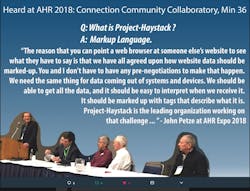Latest from IoT
Sponsored
As part of our never-ending transformation, we need to talk about Transparency which implies openness, communication, and accountability. It means operating in such a way that thoughts, feelings, or motives are easily perceived and it is easy for others to see what actions are performed.
This open-to-all transparent thinking is a significant shift from our proprietary “me” thinking of yesteryear and it is a big part of our process of Metamorphosing Me. I find my younger mentors bring clarity to the meaning of Transparency when they express puzzlement as to why a certain thing is done a certain way – it seems to make no sense! The answer is often because in the past we did not want to be transparent...Yikes!
That is a scary thought, but true. Achieving Transparency may even be scarier if we do not change the opaqueness of our mindset. We need to listen to the people who are driving the digital metamorphosis that I have been ranting on about in my last few columns, giving it a Brain, Face, Body, and Voice.
Here’s a good working definition from techtarget.com:
Transparency, in a business or governance context, is honesty and openness. Transparency and accountability are generally considered the two main pillars of good corporate governance. The implication of transparency is that all of an organization’s actions should be scrupulous enough to bear public scrutiny. Increasingly, the nature of social media and other communications means that even actions intended to be secret may be brought into the public's awareness, despite an organization's best efforts to keep them hidden.
From this Article, The New Deal Initiative by Jim Lee, CEO Cimetrics, Inc.:
Today, the industry is grappling with the impending disruption brought about by information technology, specifically the “digitalization of everything” under the moniker of the Internet of Things…
Discussing disruptive forces can be both invigorating and uncomfortable at the same time. Many in the industry that makes up CABA’s membership will be excited by the New Deal, while others will see it as unnecessary and counter to their current business priorities. A better way to view disruption is that it is inescapable, and the industry’s acceptance of this, and an open dialog about self-disruption will be much better than the inevitable external disruption from entities less able to fulfill the needs of building owners, operators, and managers.
The New Deal is based on three tenets, explained in full in the white paper:
• Open Standards
• Digital Twin
• Service Transparency
In this article How IoT is Transforming the HVACR Industry From Ronald J. Zimmer, President and CEO of CABA, comes these words:
Through new, emerging IoT technology, property owners and managers will be able to control building operations and respond to tenant requests from applications on their smart devices to provide a higher level of service. Critical issues regarding standards, APIs, cybersecurity and the cloud are the focus of much of the industry’s efforts today. These issues will be resolved, and the industry will evolve to determine how best to manage and access gargantuan data sets to yield meaningful insights designed to better manage large building portfolios. We project that real value from IoT will amass in the years ahead, as mountains of data accessed from HVACR devices are sifted, sorted and examined through complex analytics. Our research affirms that the unique value of IoT is expressed through practical applications, such as intelligent buildings, where previously isolated, standalone systems become functionality integrated, sharing data, and thereby providing wider benefits.
So how do open standards promote transparency? Here’s a quick example from the sixth annual Connection Community Collaboratory:
You could say that transparency is the foundation for all of our modern information infrastructure.
(To see video from the Collaboratory, just visit: http://www.contractormag.com/iot/transforming-our-industry-iot-ahr-expo)
So how does the digital twin help transparency? This article, Who You Gonna Call? — Digital Twins! from Anno Scholten, writing for Connexx Energy on the New Deal for Buildings blog provides some insight:
The concept of building and maintaining a digital twin is a new frontier in the industrial art of digital modeling. We are entering a time when everything is getting connected, computers are ubiquitous and the amount of data that can be collected, aggregated and analyzed is practically limitless due to cloud architectures. It is now within reach to create a full proxy of a building in the cloud.
A growing category in operational analytics for buildings is model-based predictive and prescriptive control algorithms. Fed historical and real-time trend data, these tools look for patterns to predict what will happen next… Project teams will want to plan for the eventuality of running this type of analytics against the data stored in their digital twin.
In short, a digital twin platform should accommodate tools we know today, and those we have not heard of yet. Who knows what new analytics will emerge from the minds of next-generation data scientists? Certainly, the digital twin should not be tied to any specific analytics type or brand. The architecture should feature security as well as open, low-friction data interoperability at each level. Software stacks supported by vibrant open-source communities are considered to provide the safest future growth path today. A digital twin should be designed to scale, evolve and reincarnate for the lifespan of the building it represents.
We all need to discuss what being transparent looks like -- what does the new deal mean to me?
At the 45.30-minute mark of this Vidcast and PodCast from ControlTalk NOW (for the week ending Feb. 11) we start to talk about the New deal and what is Transparency.
We also chat about the Uber example who are leaders in making transportation transparent. They know where you are, where you are going, they provide you several choices to achieve that goal, including time and price in your phone negotiated contract. Moreover, they show you information about your driver and the car picking you up while providing the dynamic location. When underway they allow you to share all of that dynamic information with anyone you choose with one click on your phone. Now your exact time and location of arrival is part of their transportation transparency.
Others are rapidly applying these concepts to their business. This was the first ControlTalk being done using https://zoom.us
This software "Online meetings as a service" had not been used by any of us, but it allowed four people from four corners of North America to respond to a Zoom generated invitation with links and instruction on how to install. We just wanted to have a live, recorded, online video meeting and the transparency of the service made for a better user experience.
We need to learn from these models of Service Transparency. How can we provide comfort as service? Lighting as a service? Location as service? Make me Happy as a service?
How we will become transparent -- "virtually invisible" -- is the new discussion everywhere in our industry. Get involved! Share your thoughts and your own story of personal metamorphosis.
Ken Sinclair | Editor/Owner/Founder
Ken Sinclair has been called an oracle of the digital age. He sees himself more as a storyteller and hopes the stories he tells will be a catalyst for the IoT future we are all (eventually) going to live. The more than 50 chapters in that ongoing story of digital transformation below are peppered with HTML links to articles containing an amazing and diverse amount of information.
Ken believes that systems will be smarter, self-learning, edgy, innovative, and sophisticated, and to create, manage and re-invent those systems the industry needs to grow our most important resource, our younger people, by reaching out to them with messages about how vibrant, vital and rewarding working in this industry can be.




